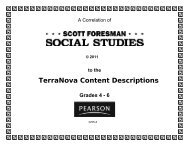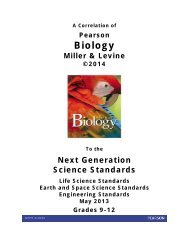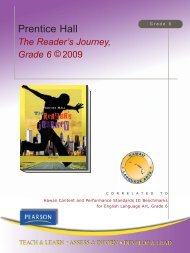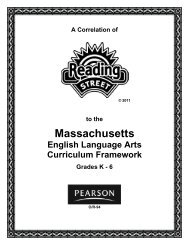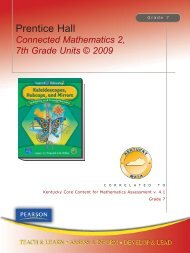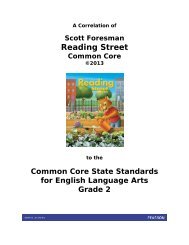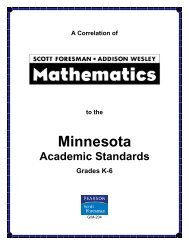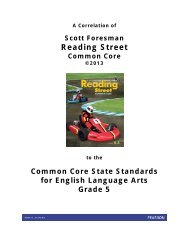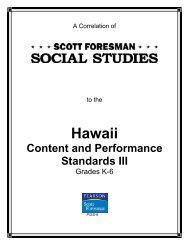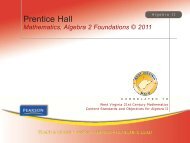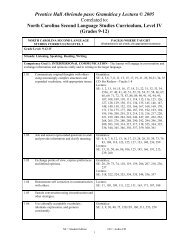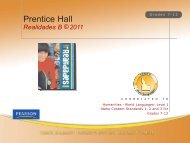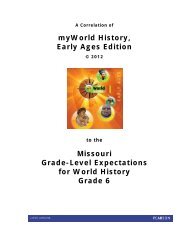Miller & Levine Biology: Foundation Edition - Pearson
Miller & Levine Biology: Foundation Edition - Pearson
Miller & Levine Biology: Foundation Edition - Pearson
You also want an ePaper? Increase the reach of your titles
YUMPU automatically turns print PDFs into web optimized ePapers that Google loves.
A Correlation of<strong>Miller</strong> & <strong>Levine</strong> <strong>Biology</strong>, <strong>Foundation</strong> <strong>Edition</strong>, ©2014to the Next Generation Science Standards, May 2013Grades 9-12HS-LS1-5. Use a model to illustrate how photosynthesis transforms light energy into stored chemical energy. [ClarificationStatement: Emphasis is on illustrating inputs and outputs of matter and the transfer and transformation of energy in photosynthesis by plants and other photosynthesizing organisms.Examples of models could include diagrams, chemical equations, and conceptual models.] [Assessment Boundary: Assessment does not include specific biochemical steps.]MILLER & LEVINE BIOLOGY, <strong>Foundation</strong> <strong>Edition</strong>: The term photosynthesis is defined in Lesson 8.1 (p. 194). Lesson 8.2 (pp. 195–197)presents an overview of the process of photosynthesis. Lesson 8.3 (pp. 199–203) provides details about the light-dependent and lightindependentsets of reactions.Representative examples of how students use a model to illustrate the conversion of light energy into chemical energy duringphotosynthesis: Students use a visual model to determine what happens to the ATP and NADPH produced during the light-dependentreactions (TE p. 197). Students draw and label a model of a chloroplast; indicate the key events in the conversion of sunlight to chemicalenergy; and expand the model to show the location of photosystems (Q1 and Q2, p. 205). Students working in small groups construct aphysical model of photosynthesis that includes both the light-dependent and light-independent reactions (TE p. 204).HS-LS1-6. Construct and revise an explanation based on evidence for how carbon, hydrogen, and oxygen from sugarmolecules may combine with other elements to form amino acids and/or other large carbon-based molecules. [ClarificationStatement: Emphasis is on using evidence from models and simulations to support explanations.] [Assessment Boundary: Assessment does not include the details of the specificchemical reactions or identification of macromolecules.]MILLER & LEVINE BIOLOGY, <strong>Foundation</strong> <strong>Edition</strong>: Carbon compounds are introduced in Lesson 2.3 (pp. 37–41). Students learn aboutthe organelles that build proteins and the organelles that capture and store energy in Lesson 7.2 (pp. 168–169). Lesson 13.2 (pp. 311–315)provides more details about the synthesis of proteins in ribosomes. Lesson 30.2 (pp. 719–722) focuses on the nutrients in food that supplythe raw materials that are used to build and repair tissues. In Lesson 30.3 (pp. 723–728), students learn how the digestive system convertsfood into small molecules that can be used by cells in the body.HS-LS1-7. Use a model to illustrate that cellular respiration is a chemical process whereby the bonds of food molecules andoxygen molecules are broken and the bonds in new compounds are formed resulting in a net transfer of energy. [ClarificationStatement: Emphasis is on the conceptual understanding of the inputs and outputs of the process of cellular respiration.] [Assessment Boundary: Assessment should not includeidentification of the steps or specific processes involved in cellular respiration.]MILLER & LEVINE BIOLOGY, <strong>Foundation</strong> <strong>Edition</strong>: Lesson 9.1 (pp. 212–215) provides an overview of cellular respiration. Lesson 9.2(pp. 216–222) provides additional details.Students use a model to illustrate their understanding of cellular respiration: Students use paper circles to model the formation of pyruvicacid from glucose (TE p. 217). Students, who are assigned different chemical identities, arrange themselves to model what takes placeduring each stage of cellular respiration (TE p. 222). Groups of students write a screenplay that shows how energy is produced in a cell(TE p. 226).The performance expectations above were developed using the following elements from the NRC document A Framework for K-12 Science Education:Science and Engineering Practices Disciplinary Core IdeasDeveloping and Using ModelsLS1.A: Structure and FunctionModeling in 9–12 builds on K–8 experiences and•Systems of specialized cells within organisms helpprogresses to using, synthesizing, and developing models them perform the essential functions of life. (HS-LS1-1)to predict and show relationships among variablesbetween systems and their components in the natural andSE/TE: Cell Specialization (p. 182);designed worlds.•Develop and use a model based on evidence to Specialized Tissues in Plants (pp. 552–555);illustrate the relationships between systems or between Neurons (p. 743); Bones (p. 767); Musclecomponents of a system. (HS-LS1-2)Tissue (pp. 770–771); Blood (pp. 790–791)SE: Q1 and Q2 (p. 185); Q1 and Q2 (p.571); Q1 (p. 735)•Use a model based on evidence to illustrate therelationships between systems or between components ofa system. (HS-LS1-4),(HS-LS1-5),(HS-LS1-7)SE: Q1 and Q2 (p. 205); Q1 and Q2 (p.253); Q4 (p. 327)TE: Active Reading (p. 197); SummativePerformance Task (p. 204); Hands-OnLearning (p. 217); Wrap-Up Activity (p. 222);Summative Performance Task (p. 226)•All cells contain genetic information in the form of DNAmolecules. Genes are regions in the DNA that contain theinstructions that code for the formation of proteins, whichcarry out most of the work of cells. (HS-LS1-1) (Note:This Disciplinary Core Idea is also addressed by HS-LS3-1.)SE/TE: Carbon Compounds (pp. 37–41);The Structure of DNA (pp. 292–285); DNAReplication (pp. 296–299); RNA Synthesis(pp. 309–310); The Genetic Code (pp. 311–312); Translation (pp. 312–315)Crosscutting ConceptsSystems and System Models•Models (e.g., physical, mathematical, computermodels) can be used to simulate systems andinteractions—including energy, matter, and informationflows—within and between systems at different scales.(HS-LS1-2), (HS-LS1-4)SE: Build Connections (p. 174); Inquiry intoScientific Thinking (p. 238); BuildConnections (p. 244)LMB: Making a Model of a Cell (pp. 337–338)Energy and Matter•Changes of energy and matter in a system can bedescribed in terms of energy and matter flows into, outof, and within that system. (HS-LS1-5), (HS-LS1-6)SE: Light-Dependent Reactions diagram (p.200); Light-Independent Reactions diagram(p. 202); Q4 (p. 243); Chapter Mystery, Q2and Q3 (p. 208)SE = Student <strong>Edition</strong>; TE = Teacher’s <strong>Edition</strong>; LMB = Lab Manual B 5



